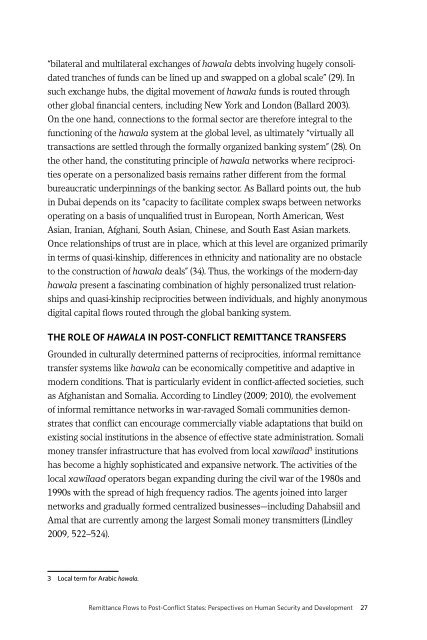Pardee-CFLP-Remittances-TF-Report
Pardee-CFLP-Remittances-TF-Report
Pardee-CFLP-Remittances-TF-Report
You also want an ePaper? Increase the reach of your titles
YUMPU automatically turns print PDFs into web optimized ePapers that Google loves.
“bilateral and multilateral exchanges of hawala debts involving hugely consolidatedtranches of funds can be lined up and swapped on a global scale” (29). Insuch exchange hubs, the digital movement of hawala funds is routed throughother global financial centers, including New York and London (Ballard 2003).On the one hand, connections to the formal sector are therefore integral to thefunctioning of the hawala system at the global level, as ultimately “virtually alltransactions are settled through the formally organized banking system” (28). Onthe other hand, the constituting principle of hawala networks where reciprocitiesoperate on a personalized basis remains rather different from the formalbureaucratic underpinnings of the banking sector. As Ballard points out, the hubin Dubai depends on its “capacity to facilitate complex swaps between networksoperating on a basis of unqualified trust in European, North American, WestAsian, Iranian, Afghani, South Asian, Chinese, and South East Asian markets.Once relationships of trust are in place, which at this level are organized primarilyin terms of quasi-kinship, differences in ethnicity and nationality are no obstacleto the construction of hawala deals” (34). Thus, the workings of the modern-dayhawala present a fascinating combination of highly personalized trust relationshipsand quasi-kinship reciprocities between individuals, and highly anonymousdigital capital flows routed through the global banking system.The Role of Hawala in Post-conflict Remittance TransfersGrounded in culturally determined patterns of reciprocities, informal remittancetransfer systems like hawala can be economically competitive and adaptive inmodern conditions. That is particularly evident in conflict-affected societies, suchas Afghanistan and Somalia. According to Lindley (2009; 2010), the evolvementof informal remittance networks in war-ravaged Somali communities demonstratesthat conflict can encourage commercially viable adaptations that build onexisting social institutions in the absence of effective state administration. Somalimoney transfer infrastructure that has evolved from local xawilaad 3 institutionshas become a highly sophisticated and expansive network. The activities of thelocal xawilaad operators began expanding during the civil war of the 1980s and1990s with the spread of high frequency radios. The agents joined into largernetworks and gradually formed centralized businesses—including Dahabsiil andAmal that are currently among the largest Somali money transmitters (Lindley2009, 522–524).3 Local term for Arabic hawala.Remittance Flows to Post-Conflict States: Perspectives on Human Security and Development 27


